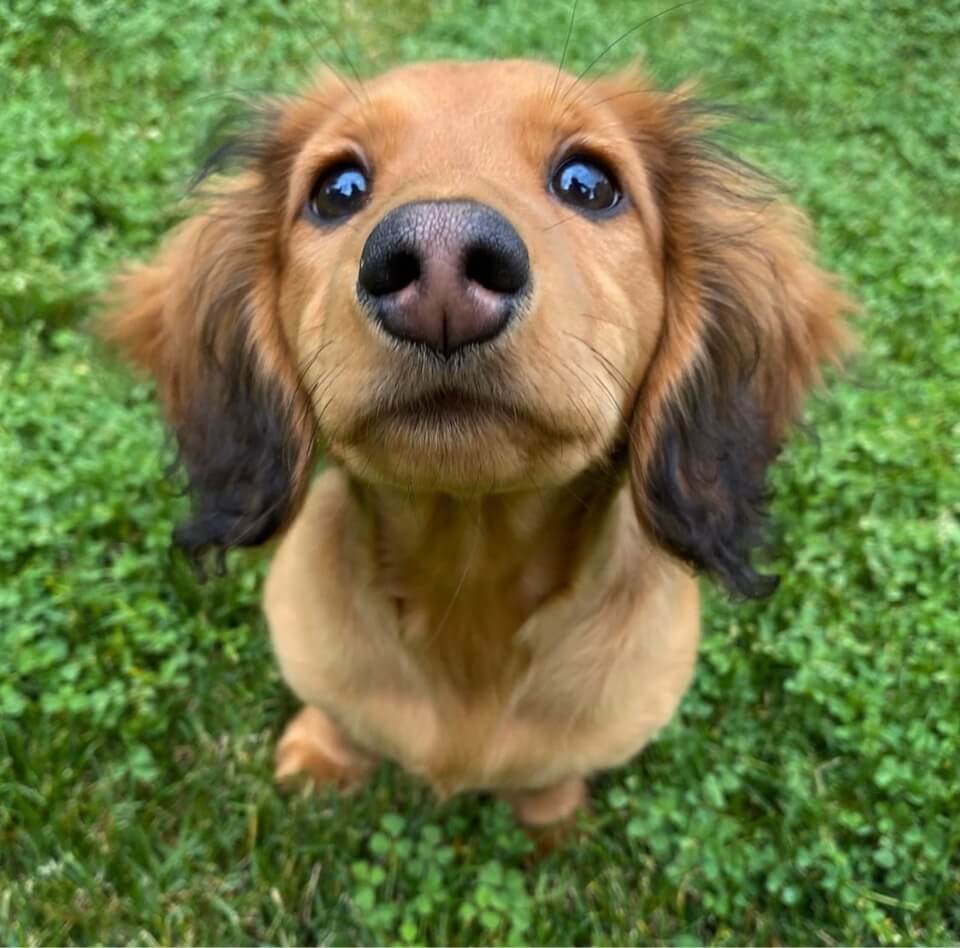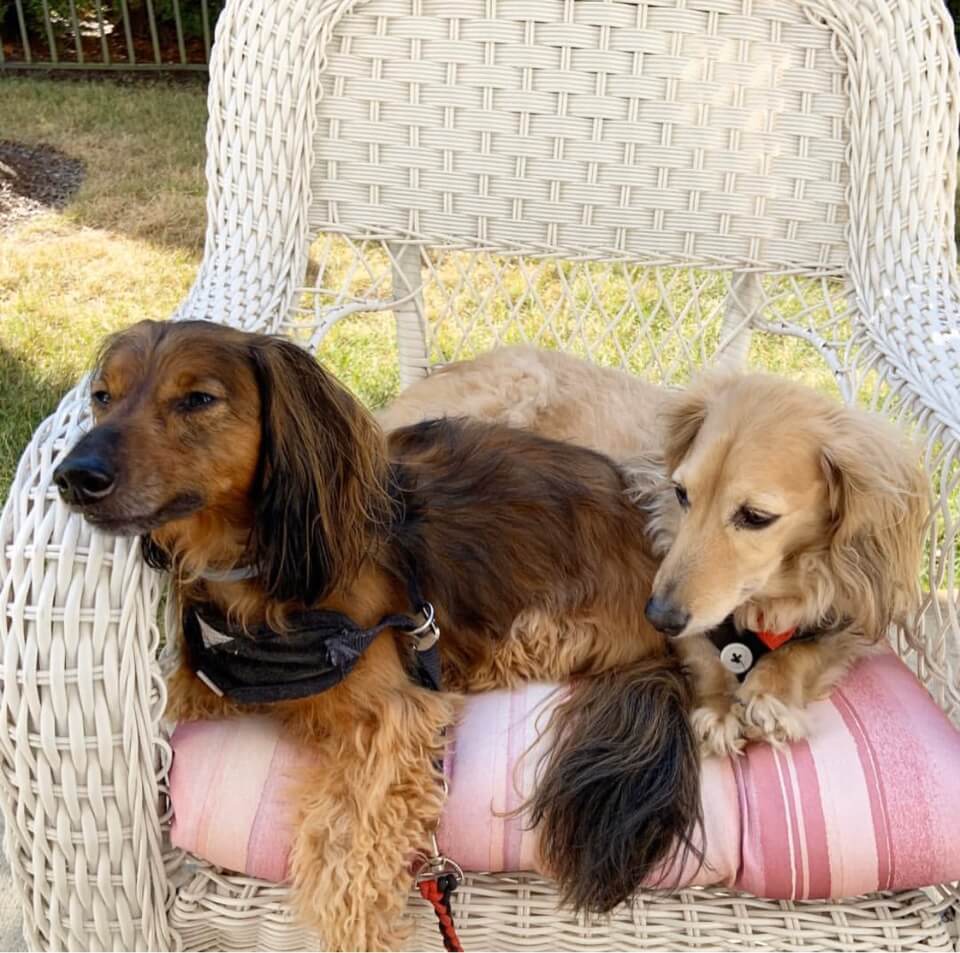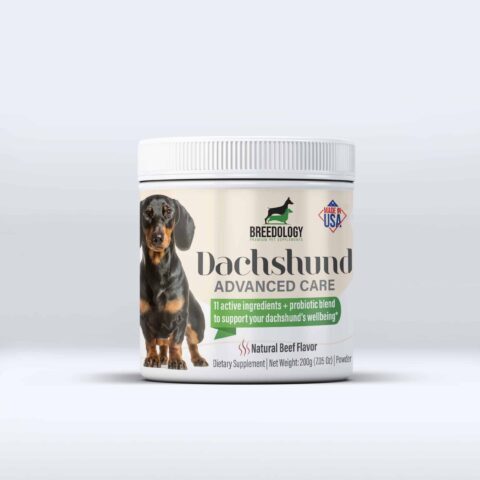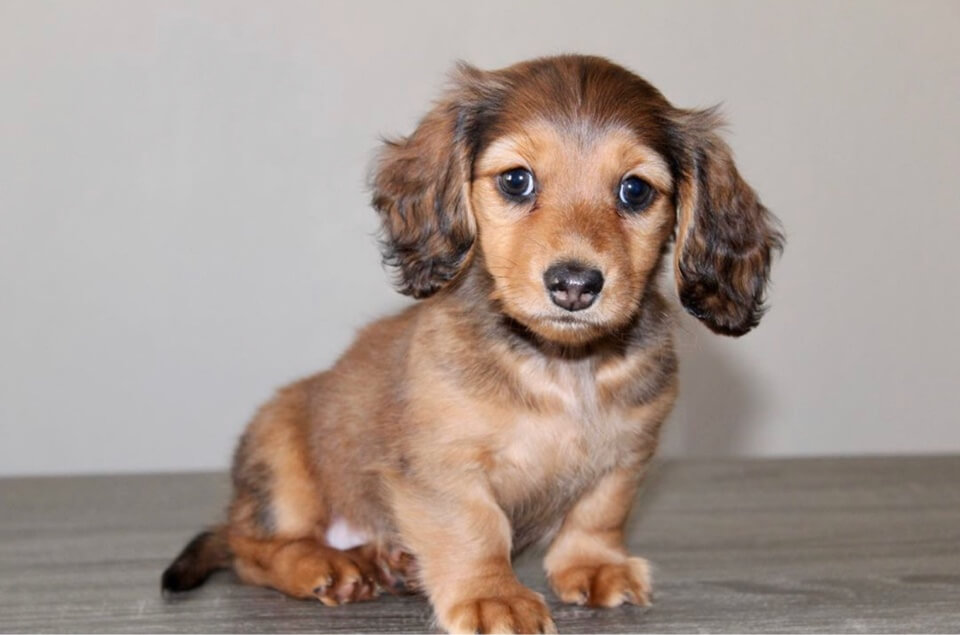There are many reasons you might be looking for a sable dachshund.
Maybe you are already a dachshund lover and are looking for a weiner dog with a distinguished look.Or maybe you are just getting into the breed, and are looking up what coat pattern would be your favourite.
Whether you are familiar or new to the breed, the Sable Dachshund is a dog that is worthy of your attention. In this article, we will tell you everything you need to know about the Sable Dachshund.
We will discuss the sable teckel’s appearance, health, and lifespan, as well as suggest how to choose a sable dachshund puppy.
Let’s get started!
What Does a Sable Dachshund Look Like?
Firstly, it is essential to know that the Sable Dachshund refers to a specific coat pattern within the breed.
If a breeder tries to tell you that sable is a sub-breed or a “designer dog,” you should probably not purchase your dachshund from them.
Sable doxie should meet the breed standard with these key characteristics:
- Standard size: 16-32 lbs (7 to 15 kg)
- Miniature size: 11 lbs or less (<5 kg)
- Long body with good muscle tone
- Muscular neck, which flows effortlessly into the shoulders
- Strong, thick pads on the feet
For the full description of dachshunds’ breed standards, please read our article Dachshunds colours, sizes, and physical characteristics.
It is also imperative that you know the Sable coat pattern is only present in the longhaired variety of dachshund.
Sable, also known as red sable, will always look black and tan from a distance. This visual trick is achieved by having a red base coat with a thick black overlay.
The Genetics Behind the Sable Pattern in Dachshunds

Eevee, @eevee_theweenie
So how does this unique sable dachshund pattern come into being? The short answer to that is – Genetics.
For a more detailed answer, you have to take a closer look at the specific genes that cause coat patterns in Dachshunds.
To begin with, every newborn dachshund will have 39 pairs of chromosomes to make up its genetics.
Namely, one allele in each pair comes from the Mother, and one comes from the Father.
It is the long genetic chains created by the chromosome pairs that will define future dachshund’s appearance. Genetics also plays a role in personality and health.
There are several series of genes that go into coat colours and patterns on Dachshunds.
Two sets of them directly cause Sable colouring.
A-series genes
The Agouti gene series, also labeled the A-series, is where the red base coat comes from for your Sable Dachshund.
There are three alleles involved that will affect which type of red base your puppy has. Those alleles are as follows:
- ay Primary dominant red coat;
- aw This allele is needed for the sable coat pattern wild boar/sable;
- at This allele creates tan points
E-series genes
The next gene series that is important for your Sable Dachshund is the “E” series.
It is this part of the weiner’s genetics that determines if they will have black pigment.
However, it only affects the pigment of the coat, not the nose, around the eyes, or nails.
When you look from the perspective of genetics, you will see that “e” is a recessive gene for black and “E” is dominant.
A dog with a double “e” cannot be a sable because it will be considered a Clear Red. Sable Dachshunds require at least one “E” to create the black pigment in their coat.
As you’ve seen genetically, the Red coat color is a dominant gene within the Dachshund breed, as is the sable coat pattern.
In other words, your puppy will only need to have one chromosome of red and one of the sable patterns to be a Sable Dachshund. Moreover, it also means that one parent must be the sable to have a true sable pattern.
A true Sable Dachshund will have black bands along the tip of each hair, with the base colour starting closer to the skin.
It is crucial to mention that there are several darker shades of red, or a coat called shaded red that can be confused with sable.
An excellent way to make sure you have a true sable pattern is to lift some of the fur strands and have a look. You should see that red color at the base, with the black bands closer to the tip of the hair.
The best way to help your dachshund live longer?
Watch our video to find out!
Sable Dachshund Lifespan
All Dachshunds are generally fairly robust dogs. The sable doxie is no different.
On average, you can expect your sable dachshund to live 12 to 16 years.
Make sure you get regular vet checkups and keep your canine friend vaccinated.
Sable Dachshund Price
 Baxter (Sable) and Briley (English Cream) , @two_cuddly_dachshunds
Baxter (Sable) and Briley (English Cream) , @two_cuddly_dachshunds
Pricing for your Sable Dachshund will depend on several different factors, like location and the dog’s pedigree.
On average, however, you can look to pay 800-1500 dollars from a responsible breeder. For the dogs with the top pedigree, the price may be even higher.
Sable Dachshund Health
The good news about the sable dachshund is that currently, there are no known health issues related directly to the genetics of the coat pattern.
All that you will need to keep a lookout for are the standard issues that can happen with all dachshunds and other breeds of dogs.
There are several common health issues that weiner dogs are prone to getting.
In this article, we will outline a few most common health issues you should keep an eye out for.
IVDD
Firstly, you will need to look after your dachshund spine. Since Sable Dachshunds have long low-slung backs, they are prone to many kinds of back issues.
Paralysis caused by Intervertebral Disk Disease is the most common back issue for these spunky little dogs. One our of four sausage dogs will suffer from IVDD in their life.
Injury is a common way for back issues to come about in dachshunds, but there can also be genetics at play. It is the reason why you will want to research your breeder and ask to see the puppy’s health records.
One of the most important and effective measures to prevent IVDD is Supplementation.
We highly recommend the Dachshund Advanced Care by Breedology, it is an advanced dietary supplement, precisely formulated for the dachshund breed. Their powerful natural formula includes Chondroitin, Glucosamine and Hyaluronic Acid among other ingredients that work in perfect synergy to provide advanced joint and cartilage support for dachshunds at any age.

Eye issues
Secondly, Dachshunds are prone to having eye issues. Namely, they can get cataracts, dry eye, or Progressive Retinal Atrophy. PRA has no cure, and because it is a degenerative eye disease, many dogs will end up blind.
If your dog has PRA, it’s important to remember that most dogs get along just fine when blind. You may need to make a few changes to your living environment, but your companion can live a quality life.
If you want to find out more, feel free to read our article about Eye Problems In Dachshunds.
Obesity
Thirdly, you need to watch out for obesity. If a dachshund becomes obese, it can put a lot of strain on their backs and lead to various health conditions.
Try to keep from giving your dachshund any scraps from the table, and don’t overfeed them.
If you do notice weight gain in your sausage dog, you may want to add more to its daily activity schedule to help it slim down. Do not cut back on food or put your dog on a “diet” without consulting a vet first.
Seizures
Also, you should be on the lookout for seizures in your teckel. Seizures in dachshunds can be anywhere on the spectrum from mild and hardly noticeable to severe episodes.
Seizure conditions are often genetic, but they can also appear in just one animal in the family.
While seizures can be alarming, they can also be treated. If your sable dachshund has a seizure, it is essential to go to your vet. Seizure conditions can be treated with medication.
Tumours
Finally, dachshunds are prone to mammary tumours, in either gender. Unsprayed female dogs are at most risk. The best way to keep this from happening is to have your dog fixed (sprayed) at an early age.
If you don’t have plans to show and breed your doxie, then it is the best thing you can do to avoid mammary tumours. Males fixed before 6 months of age and females before their first heat cycle are 98% less likely to develop mammary tumours.
Sable Dachshund Activity Requirements
Firstly, be aware that no matter what kind of activity you do with your sable dachshund, there are a few things you should not let them do.
To safeguard against back injury, you should not allow your dachshund to jump on and off furniture, beds, or anything of similar height.
You should also never let them go up and down steep stairs or large staircases.
These activities can lead to serious back injuries. The good news is that you can buy a special rump that will help your dachshund up and down from furniture, and you can just carry them up and down flights of stairs.
Dachshunds were originally bred to hunt burrow animals such as badgers, so they do well with activity. One hour per day is the minimum amount of exercise your sable dachshund needs to remain happy and healthy.
You can go to the dog park, for walks, and hikes on mild terrain and have a happy companion trotting along. Dachshunds are not much for climbing, and they tend to prefer the flat ground, like forest floors to run on.
Dachshunds also love spending time with their family so that you can work their exercise directly into family events.
If you have a BBQ outside, bring along your puppies’ favorite toy and play fetch. Alternatively, you could just let your four-legged ball of energy play with the kids and run around the yard. The activity routine with your dachshund doesn’t have to be boring, and you can make it fun for everyone.
How to Choose Your Sable Dachshund Puppy
 Eevee, @eevee_theweenie
Eevee, @eevee_theweenie
Once you have found a couple of breeders to choose your sable dachshund puppy from, it’s time to meet the litter and pick the right puppy for you.
When you first arrive, you will want to look the puppies over to ensure you see signs of good health.
Namely, some of the critical signs to look for include:
- Healthy appetite
- Bright eyes free of any discharge
- No nasal discharge
- Shiny coat
- No excessive scratching
- Healthy teeth
- Good energy levels
If the litter passes the basic health test, it will be time to move onto the temperament test.
Temperament is one of the most important things to consider when selecting a puppy. If you follow four necessary steps, you will have a good idea of which puppy fits best with your family.
Test 1: Littermate interaction
Without a doubt, you can tell a lot by the way a puppy interacts with their litter mates. It won’t take long for you to see which puppies are dominant, which are submissive, and who falls in between.
If this is your first puppy, you will want one of the in-between puppies. Overly dominate, and overly submissive dogs can be more of a challenge to train.
Test 2: Pick your sable dachshund puppy up
For this test, you will want to gently lift your puppy a few inches off the ground by holding them mid-body. Because this something different for the puppies, you can tell a lot from their first reaction. Calmer puppies will allow this without much if any struggle, others will struggle and want to be let down immediately.
Test 3: Cradle your sable dachshund puppy
Last but not least, take your puppy and cradle them like a baby and then settle them in your lap, making sure you keep petting them. Puppies that settle in without much struggle tend to be less nervous temperament wise.
On the other hand, those puppies who won’t settle at all will likely take more training as they grow to build their confidence.
To Summarise
Now that you are armed with all of the information you need to pick your sable dachshund, you can start looking. It can take time to find the perfect puppy, that is normal, and you should never feel rushed.
Make sure you ask breeders questions and take notes before you go for a meet and greet. As long as you keep yourself informed and follow the steps outlined in this article, you will get just the right sable dachshund for your family.
Other dachshund Coat Patterns
On our website, you will find the detailed articles about other dachshunds’ patterns, such as:
Written by: Kathryn Sullivan
What is your query about?
What is sable dachshund?
Sable dachshund is a dachshund that has a sable coat pattern. A true sable dachshund will have black bands along the tip of each hair, with the base colour (generally red) starting closer to the skin.
Is sable dachshund only longhaired?
Yes, the sable pattern in dachshunds is only present in longhaired variety.
Is sable dachshund rare?
Yes, the sable dachshund is considered the rarest dachshund variety out of all dachshund patterns. However, people often confuse sable dachshund with the red dachshund because of the black overlay (tan points).
What makes the sable pattern in dachshunds?
Genetics is responsible for the sable pattern in dachshunds. The A-series define the red base colour, whereas E-series genes are responsible for the black pigment on the tips of the hair. Your puppy will only need one chromosome of red and one of the sable patterns to become a Sable dachshund.
How much is a sable dachshund?
Sable dachshund can cost 800 to 1500 dollars on average. For the dogs with the top pedigree, the price might be even higher.
How long do sable dachsunds live?
Sable dachshund lives 12 to 16 years on average.


